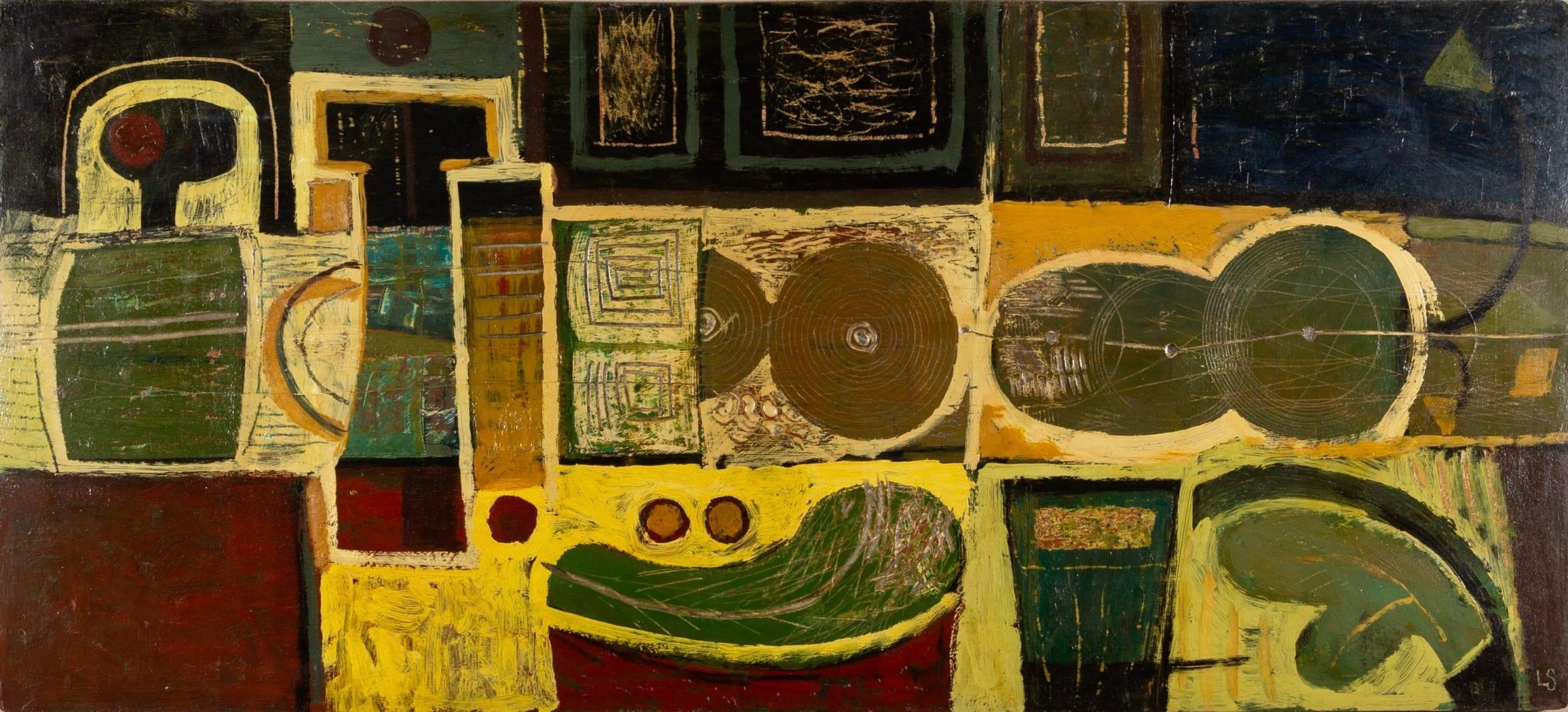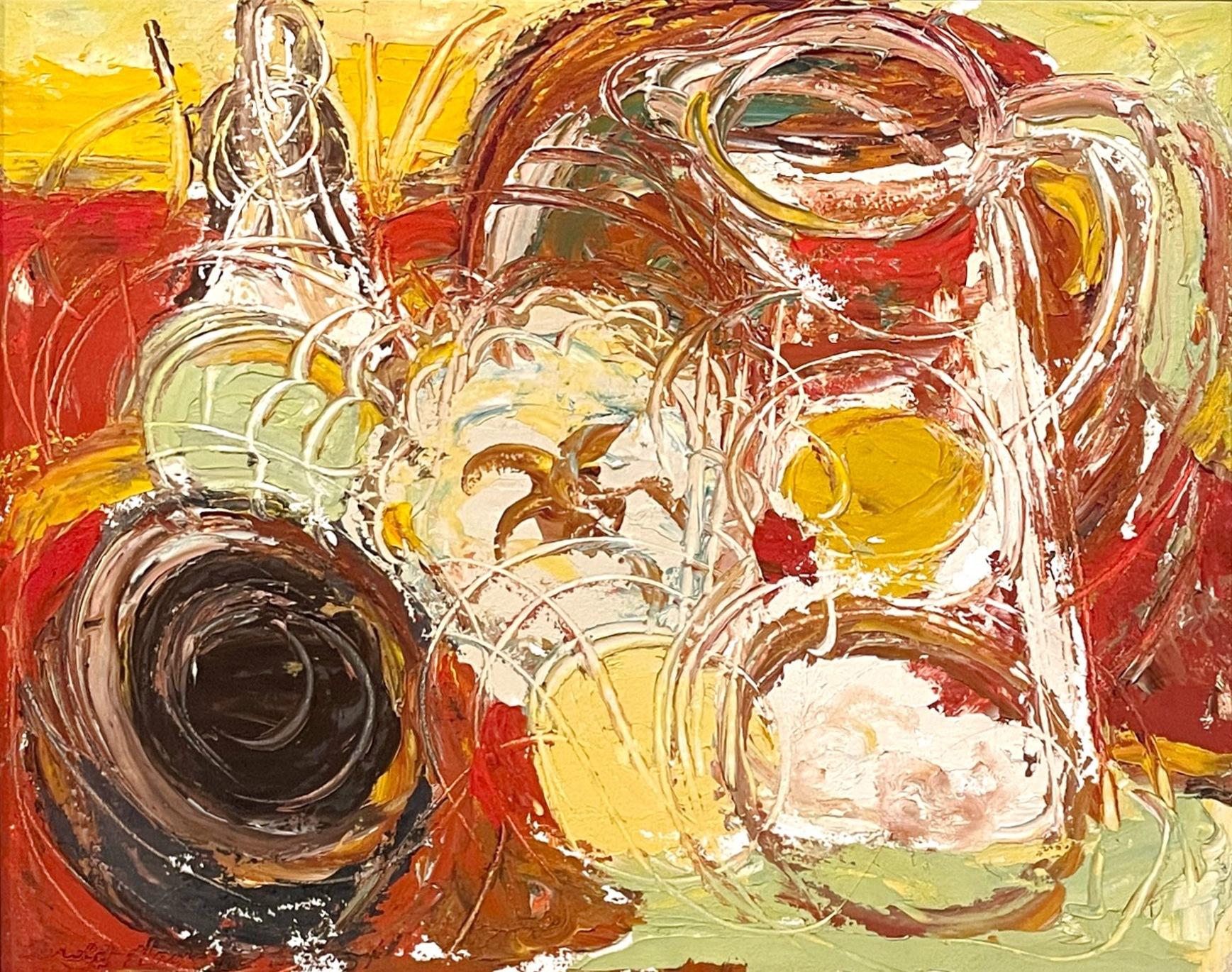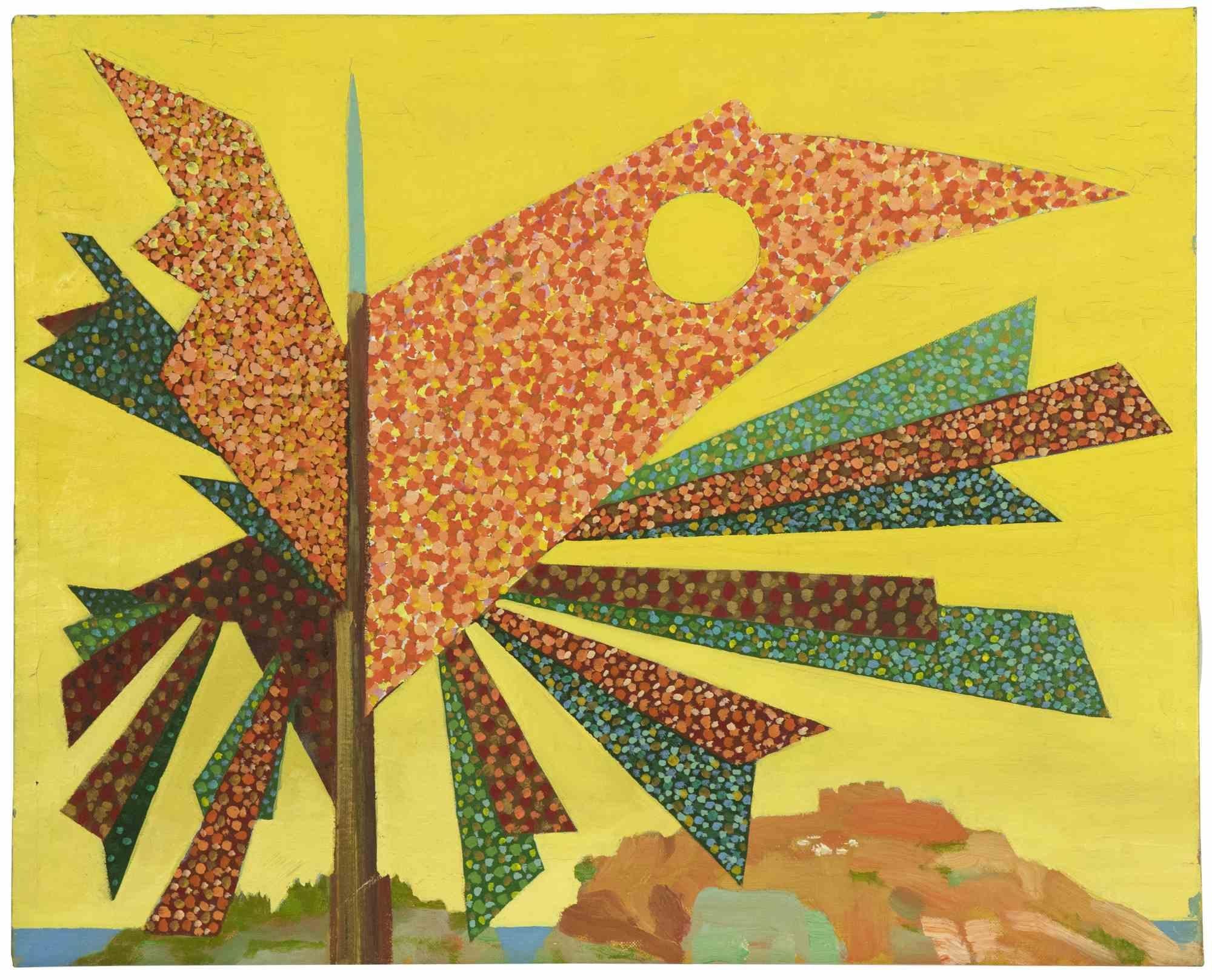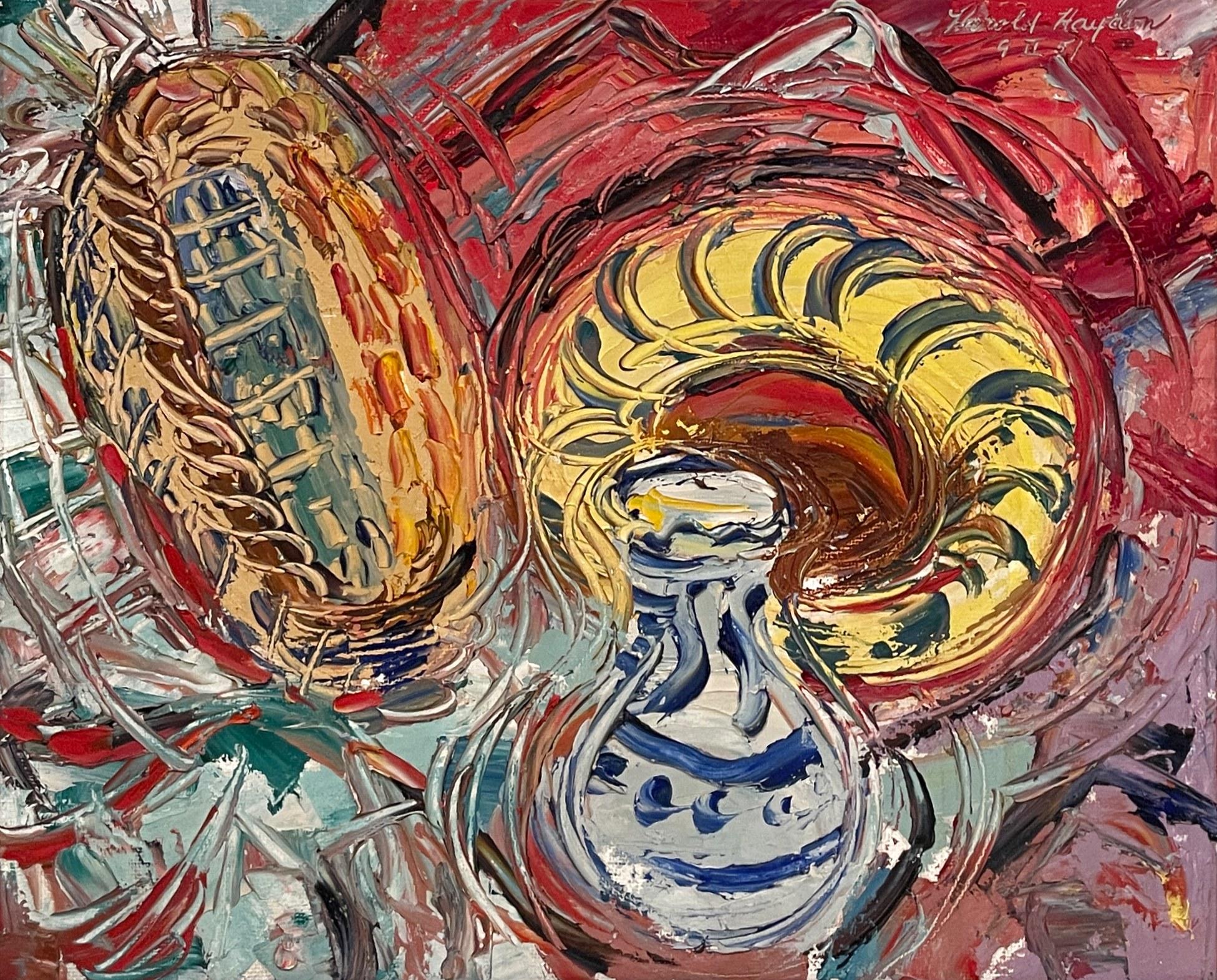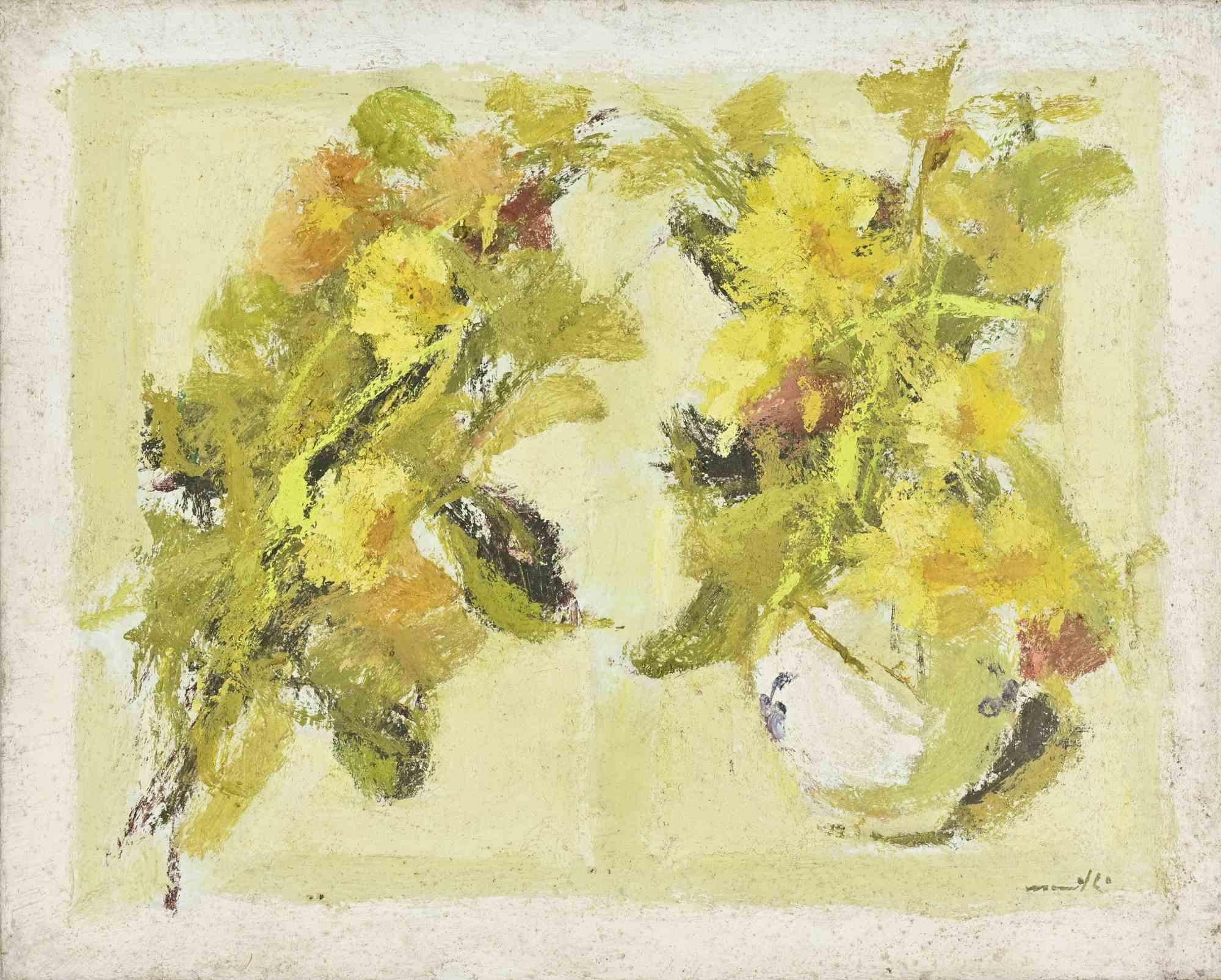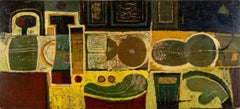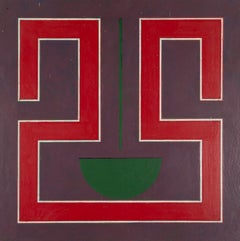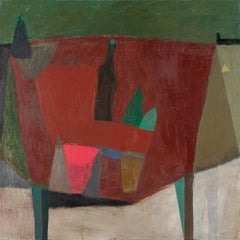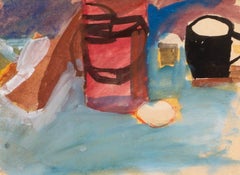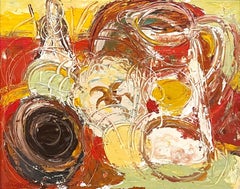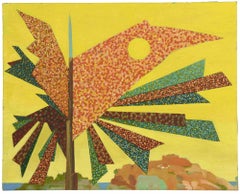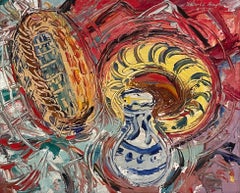Items Similar to Mosaic, 1960 - 20th C Abstracted Still Life Oil Painting, Yellow, Green + Red
Want more images or videos?
Request additional images or videos from the seller
1 of 9
Laurence ScarfeMosaic, 1960 - 20th C Abstracted Still Life Oil Painting, Yellow, Green + Red1960
1960
Price Upon Request
Price Upon Request
Price Upon Request
Price Upon Request
Price Upon Request
Price Upon Request
Price Upon Request
Price Upon Request
Price Upon Request
Price Upon Request
About the Item
Laurence Scarfe 1914-1993
Mosaic, 1960
oil on board
50.8 x 111.8 cm
20 x 44 in
signed with initials; signed again, dated and titled verso
Laurence Scarfe was a multi-disciplinary Modern British artist who worked in London.
Scarfe was born in Idle, Yorkshire, and attended the Shipley School of Art before moving to London to study painting at the Royal College of Art (1933-37).
He carried out mural work for the British Pavilion at the 1937 Exposition Internationale des Arts et Techniques dans la Vie Moderne in Paris, the Books & Printing section at Britain Can Make It (1946) and the British Industries Fair (1948). Of major importance were his murals for the Dome of Discovery and the Regatta Restaurant at the Festival of Britain’s South Bank site (1951). Other murals included those for the P&O liners Orcades and Oriana in the '50s.
Though he found success as a commercial artist, Scarfe enjoyed teaching and lectured part-time for many years, including at the Bromley School of Art (1937-39), Central School of Art (1945-70) and Brighton Polytechnic, where he taught the History of Illustration and Graphic Design before retiring from teaching in 1980.
Scarfe travelled extensively throughout Europe from 1947 to '69, most enjoying Italy, Sicily and Malta, and European thinking heavily influenced his ideas on painting theory. He was a member of the Society of Mural Painters and a Fellow of the Society of Industrial Artist and Designers. The majority of the artist's papers from the focal years of his career, 1935 to '83, are held in the V&A Archive of Art & Design.
Scarfe's work represents a range of personal influences, through periods of design and theoretically-focused work before the Second World War, through the optimism and growth of the Festival of Britain period and the abstract movements of the seventies. In his later years, Scarfe began to create more pictorial and pastoral work.
Laurence Scarfe's work found wide renown in his life and has been exhibited at the Leicester Galleries, Redfern Gallery, Zwemmer Galleries, New Burlington Gallery, Victoria and Albert Museum, Royal Academy, Society of Watercolour Painters, Orleans House Chiswick, as well as various galleries in the USA. He is represented in public collections throughout the UK, including the Imperial War Museum, (DCMS) Government Art Collection, Victoria and Albert Museum, Royal Institute of British Architects, Ministry of Works, University of Warwick Collection, Graves Art Gallery, Bradford Art Gallery, Brighton Museum, and the Tate.
About the Seller
No Reviews Yet
Vetted Professional Seller
Every seller passes strict standards for authenticity and reliability
Established in 2010
1stDibs seller since 2024
41 sales on 1stDibs
Typical response time: 8 hours
- ShippingRetrieving quote...Shipping from: Kingsclere, United Kingdom
- Return Policy
Authenticity Guarantee
In the unlikely event there’s an issue with an item’s authenticity, contact us within 1 year for a full refund. DetailsMoney-Back Guarantee
If your item is not as described, is damaged in transit, or does not arrive, contact us within 7 days for a full refund. Details24-Hour Cancellation
You have a 24-hour grace period in which to reconsider your purchase, with no questions asked.Vetted Professional Sellers
Our world-class sellers must adhere to strict standards for service and quality, maintaining the integrity of our listings.Price-Match Guarantee
If you find that a seller listed the same item for a lower price elsewhere, we’ll match it.Trusted Global Delivery
Our best-in-class carrier network provides specialized shipping options worldwide, including custom delivery.More From This Seller
View AllMosaic, Oil on Board Painting by Laurence Scarfe, 1960
Located in Kingsclere, GB
Mosaic, Oil on Board Painting by Laurence Scarfe, 1960
Additional information:
Medium: Oil on board
50.8 x 111.8 cm
20 x 44 in
Signed with initials; signed again, dated and titled v...
Category
20th Century Abstract Paintings
Materials
Board
Price Upon Request
Red Forms with Small Green Segment - Bold 1960s Abstract Oil Painting, Sixties
By Gordon House
Located in Kingsclere, GB
Gordon House was born in 1932 in Pontardawe, South Wales. Early exposure to art on trips to the Glynn Vivian Art Gallery as a young boy inspired House towards creative endeavors and at the age of fourteen he was awarded a grant to enter art school which he accepted. From 1947 to 1950 he studied at Luton School of Art, Bedfordshire, and St. Albans School of Art, Hertfordshire. House's contemporaries included Richard Smith and John Plumb with whom he remained close. During the early fifties, after finishing art school, House began work as assistant to the ecclesiastical sculptor Theodore Kern. He also spent time at an advertising studio where he honed his burgeoning skills in typography and graphic design. In 1952 House was offered the position of designer for Imperial Chemical Industries Plastics Division where he stayed until 1959. This was followed by two years spent as graphic designer for the Kynoch Press in London. In 1961 House set out on his own as a self-employed designer and typographer. Initially this was supplemented by part-time teaching at art schools in and around London but by 1964 House was able to devote himself entirely to his design work which freed up valuable time to concentrate on his own artistic output in the studio.
In the late fifties, informed by the new art emerging from America and that of his contemporaries in England, House began to create large-scale abstract works which he was invited to show in 1959 at Dennis Bowen's legendary New Vision Centre in Marble Arch.
House was an active participant in the vibrant London art scene of the sixties, regularly attending lectures, exhibitions and discussions. In 1960 he exhibited in 'Situation' the key abstract exhibition of the decade held at the RBA Galleries. Other participating artists included Robyn Denny, Bernard and Harold Cohen, Gillian Ayres, John Hoyland, Richard Smith and William Turnbull among others. These artists, united by a common admiration for American Abstract Expressionism, were frustrated by the lack of exposure given to large-scale abstract works in commercial galleries so they organised their own exhibition. The name was derived from the participants' idea that an abstract painting that occupied the whole field of vision would involve the spectator in an 'event' or 'situation'. This exhibition was followed by 'New London Situation' in 1961 and a nationwide touring Arts Council presentation in recognition of the significance of the two earlier shows.
In 1961 House began producing his first prints at the Kelpra Studio, run by Chris and Rose Prater, where he made the earliest fine art screenprint ever to be produced in Britain. Artists such as Paolozzi and Hamilton followed in his footsteps and together they started a printmaking revolution in Britain. They cemented the medium of the screenprint in the world of fine art as opposed to the commercial sphere and secured the reputation of Kelpra in the process. Later, together with Cliff White, House set up the White Ink (Ltd.) print studio in London, where he produced etchings and wood engravings on a series of magnificent antique printing presses...
Category
20th Century Abstract Paintings
Materials
Oil, Board
Red Table and Light House - Contemporary Still Life Oil Painting, Red + Green
By Nicholas Turner
Located in Kingsclere, GB
Nicholas Turner b. 1972
Red Table and Light House, 2022-2024
oil on canvas
61 x 61 cm
24 x 24 in
signed, dated and titled verso
Born in London, Turner spent many years in Bristol b...
Category
21st Century and Contemporary Still-life Paintings
Materials
Canvas, Oil
Still Life on a Table, Gouache Painting by Peter Potworowski, 1954
Located in Kingsclere, GB
Still Life on a Table, Gouache Painting by Peter Potworowski, 1954
Additional information:
Medium: Gouache
23.6 x 33.3 cm
9 1/4 x 13 1/8 in
Tadeusz Piotr (Peter) Potworowski was a Polish abstract and figurative painter who lived and exhibited in Paris, Poland, Sweden and England.
Potworowski was born in Warsaw in 1898. After serving in the First World War, Potworowski enrolled at the Warsaw University of Technology to study architecture, though his studies were halted by the Bolshevik campaign. After the end of the Polish-Soviet War in 1921, Potworowski returned to Warsaw and began to study art at the school of Konrad Krzyżanowski. By the following year, he had taken a place at the Academy of Fine Arts in Krakow, where he studied under Józef Pankiewicz. It was Pankiewicz who incorporated Potworowski into the Paris Commute, or Kapists, a group of Polish artists who travelled to the French capital in 1924.
During his seven years in Paris he became personally acquainted with Pablo Picasso, Pierre Bonnard, Jean Cocteau, Constantin Brancusi and attended for a short time Fernand Léger's studio. It was through this job that he met his first wife Magdalena Mańkowska, a student of anthropology in Paris. After marrying in France, and visiting Britain in 1928, the couple returned to Poland in 1930, where their first son John was born.
In 1931, Warsaw was the locale of the first Kapists exhibition, entitled New Generation, which took place at the Artist's Club, Hotel Polonia, and the Institute of Art Propaganda. Here, Potworowski received a prize for his painting Three Women in the Interior. The following year, he held his first solo exhibition at the Makowski Salon in Poznań. This success was sustained through 1937 when the artist received a silver medal at the International Exhibition of Art and Technology in Paris, as well as the award from the Minister of Foreign Affairs. After this strong development, Potworowski had a travelling solo exhibition arranged, held in 1938 at the Institute of Propaganda of Art in Warsaw and then in Lviv.
Following the invasion of Poland in 1939, Potworowski escaped to Sweden via Lithuania. It was from here that the artist, with his wife and two young children, made his way to Britain, arriving in 1943. After serving in Scotland, Potworowski settled in London, and in January 1946, an exhibition of 33 of his works was held at the Redfern Gallery. This was followed by regular exhibitions with the Redfern, Gimpel Fils (1948 onwards) and The London Group, to which he was elected a member in 1949. He was also the president of the Association of Polish Artists and published regularly in the monthly magazine "Nowa Polska".
Potworowski's teaching career included eight years as Professor of Painting at the Bath Academy of Art, Corsham (1949-57), where he had considerable European influence, specifically on abstraction, and was acknowledged by contemporaries including Peter Lanyon, Bryan Wynter...
Category
20th Century Abstract Paintings
Materials
Gouache
Still Life, Red & Yellow Flowers, Gouache Painting by Peter Potworowski, c 1955
Located in Kingsclere, GB
Still Life, Red & Yellow Flowers, Gouache Painting by Peter Potworowski, c 1955
Additional information:
Medium: Gouache
23.6 x 33.3 cm
9 1/4 x 13 1/8 in
Tadeusz Piotr (Peter) Potworowski was a Polish abstract and figurative painter who lived and exhibited in Paris, Poland, Sweden and England.
Potworowski was born in Warsaw in 1898. After serving in the First World War, Potworowski enrolled at the Warsaw University of Technology to study architecture, though his studies were halted by the Bolshevik campaign. After the end of the Polish-Soviet War in 1921, Potworowski returned to Warsaw and began to study art at the school of Konrad Krzyżanowski. By the following year, he had taken a place at the Academy of Fine Arts in Krakow, where he studied under Józef Pankiewicz. It was Pankiewicz who incorporated Potworowski into the Paris Commute, or Kapists, a group of Polish artists who travelled to the French capital in 1924.
During his seven years in Paris he became personally acquainted with Pablo Picasso, Pierre Bonnard, Jean Cocteau, Constantin Brancusi and attended for a short time Fernand Léger's studio. It was through this job that he met his first wife Magdalena Mańkowska, a student of anthropology in Paris. After marrying in France, and visiting Britain in 1928, the couple returned to Poland in 1930, where their first son John was born.
In 1931, Warsaw was the locale of the first Kapists exhibition, entitled New Generation, which took place at the Artist's Club, Hotel Polonia, and the Institute of Art Propaganda. Here, Potworowski received a prize for his painting Three Women in the Interior. The following year, he held his first solo exhibition at the Makowski Salon in Poznań. This success was sustained through 1937 when the artist received a silver medal at the International Exhibition of Art and Technology in Paris, as well as the award from the Minister of Foreign Affairs. After this strong development, Potworowski had a travelling solo exhibition arranged, held in 1938 at the Institute of Propaganda of Art in Warsaw and then in Lviv.
Following the invasion of Poland in 1939, Potworowski escaped to Sweden via Lithuania. It was from here that the artist, with his wife and two young children, made his way to Britain, arriving in 1943. After serving in Scotland, Potworowski settled in London, and in January 1946, an exhibition of 33 of his works was held at the Redfern Gallery. This was followed by regular exhibitions with the Redfern, Gimpel Fils (1948 onwards) and The London Group, to which he was elected a member in 1949. He was also the president of the Association of Polish Artists and published regularly in the monthly magazine "Nowa Polska".
Potworowski's teaching career included eight years as Professor of Painting at the Bath Academy of Art, Corsham (1949-57), where he had considerable European influence, specifically on abstraction, and was acknowledged by contemporaries including Peter Lanyon, Bryan Wynter...
Category
20th Century Abstract Paintings
Materials
Gouache
Samphire Autumn, 2013 - Acrylic on Board Abstract Painting, Yellow and Brown
By Peter Joyce
Located in Kingsclere, GB
Peter Joyce was born in Poole, Dorset, and was educated at Bournemouth & Poole College of Art & Design from 1980. He went on to study at Stourbridge College of Technology & Art and q...
Category
21st Century and Contemporary Abstract Abstract Paintings
Materials
Acrylic, Board
You May Also Like
A Colorful, Expressionist 1950s Mid-Century Modern Still Life Painting
By Harold Haydon
Located in Chicago, IL
A Vibrant, Expressionist 1950s Mid-Century Modern Still Life Painting by Notable Chicago Artist, Harold Haydon (Am. 1909-1994). Depicting a bright and vivid studio still life scene ...
Category
Mid-20th Century Surrealist Still-life Paintings
Materials
Masonite, Oil
Abstract in Yellow Green & Red - British 1955 abstract art oil painting
Located in Hagley, England
This superb British 1950's abstract oil on board painting is by noted Slade School trained contemporary artist Leo Davy. Davy was born in Yorkshire but settled in Cornwall in 1968 an...
Category
1950s Abstract Abstract Paintings
Materials
Oil
$8,787 Sale Price
20% Off
Yellow Composition - Oil on Canvas by Leo Guida - 1970s
By Leo Guida
Located in Roma, IT
Yellow Composition is a contemporary artwork realized by Leo Guida in 1970s.
Mixed colored oil on canvas
Leo Guida (1992 - 2017). S ensitive to current issues, artistic movements ...
Category
1970s Abstract Abstract Paintings
Materials
Oil
A Colorful Expressionist 1950s Mid-Century Modern Still Life Painting
By Harold Haydon
Located in Chicago, IL
A Vibrant, Expressionist 1950s Mid-Century Modern Still Life Painting by Notable Chicago Artist, Harold Haydon (Am. 1909-1994). Depicting a bright and cheerful studio still life sce...
Category
Mid-20th Century Surrealist Still-life Paintings
Materials
Oil, Masonite
Still Life - Oil Painting by Franco Marzilli - 1970s
By Franco Marzilli
Located in Roma, IT
Oil on canvas realized by Franco Marzilli (1934-2010) in 1970s.
Hand signed lower right.
Very good condition.
Franco Marzilli was born in Rome in 1934. He received his first artis...
Category
1970s Contemporary Figurative Paintings
Materials
Oil
$503 Sale Price
25% Off
Postmodern Abstraction oil on canvas, Arnold Schreibman, 1991, Red yellow green
Located in Brooklyn, NY
Stunning modern / Postmodern painterly abstraction with gorgeous knife work and thick impasto, vibrant, genius colors and juxtapositions. Fresh, unexpected yet very much reminiscent of the traditional landscape painting.
Category
Late 20th Century American Mid-Century Modern Paintings
Materials
Paint
$1,350 Sale Price
27% Off
More Ways To Browse
Sicily Vintage
Festival Of Britain
Ora Sorensen
Painting And Clementines
Paintings Of Hydrangeas
Platinum Seller
Quail Eggs
Rose Johnson
Stephanie Richards
Sunflower Painting With Frame
Sushi Painting
White Orchid Paintings
Adult Toy
Anna Costa Paintings
Barbara Woods Oil Painting
Colin Fraser
Daniel Keys
Dark Floral Oil Painting
